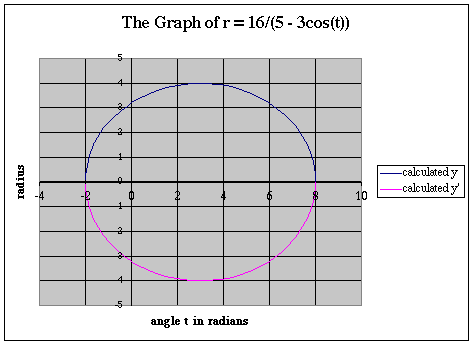
Consider the functions below:
![]() ,
,![]() ,
,
![]()
These functions are most easily graphed using graphing software, however if such software is not available or if instruction of conversion of equations in polar coordinates to equations in rectangular coordinates is the aim of the lesson, then one could use a spreadsheet to plot the equations above.
To do so we must convert the polar equations to rectangular coordinates using the following formulas:
![]() ,
x = r cos ø , y = r sin ø.
,
x = r cos ø , y = r sin ø.
![]() can be converted to rectangular coordinates by cross multiplying
resulting in
can be converted to rectangular coordinates by cross multiplying
resulting in
5r - 3r cos ø = 16. Now we can use the conversion equations above to convert this equation to rectangular coordinates. Substituting and simplifying results in the following equation.
![]()
Since in a spreadsheet one can not enter implicitly stated relations, one must find an explicit expression for this relation. To do so simply solve for y, being careful to note that one must plot both the positive and the negative result when the square root of y is computed. The resulting equations are:
![]() ,
,
![]() .
.
Now we are ready to graph our equations using a spreadsheet.
To use a spreadsheet to graph the equations we have calculated above we must calculate a table of values for
![]() and
and ![]() .
.
To do so we must enter a column of ø's. Using the ø's
and the given equation in polar form ![]() we
must calculate r. Then we can use x = r cos ø to calculate
a column of x's and finally the two equations for y to calculate
the y's. The resulting table should look like this. Where the
calculated y's are
we
must calculate r. Then we can use x = r cos ø to calculate
a column of x's and finally the two equations for y to calculate
the y's. The resulting table should look like this. Where the
calculated y's are ![]() and the calculated ( y')'s aare
and the calculated ( y')'s aare ![]() .
.
| ø | r | x | calculated y | calculated y' |
| -3.4 | 2.0252153031805 | -1.95797449469917 | 0.51752575041635 | -0.51752575041635 |
| -3.3 | 2.00943446821065 | -1.98427588631559 | 0.316979635023264 | -0.316979635023264 |
| -3.2 | 2.00127973649305 | -1.99786710584491 | 0.116822990376771 | -0.116822990376771 |
| -3.1 | 2.00064884772846 | -1.99891858711924 | 0.0831883043849602 | -0.0831883043849602 |
| -3 | 2.00753390087665 | -1.98744349853891 | 0.28330320027217 | -0.28330320027217 |
| -2.9 | 2.02202120218167 | -1.96329799636388 | 0.483767216278413 | -0.483767216278413 |
Now the x and y values can be easily ploted into a chart using the scatterplot option. The resulting graph with have two curves denoted by two different colored lines such as the one below.

The method outlined above can be used to graph any relation given in polar form that can be solved explicitly when converted to rectangular form.
For example, given the following relation in polar form![]() we can
graph the relation in a spreadsheet by graphing the equation in
rectangular form. Looking at the following spreadsheet chart,
one can tell that the equation in rectangular coordinates is
we can
graph the relation in a spreadsheet by graphing the equation in
rectangular form. Looking at the following spreadsheet chart,
one can tell that the equation in rectangular coordinates is
![]()
